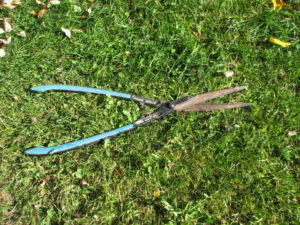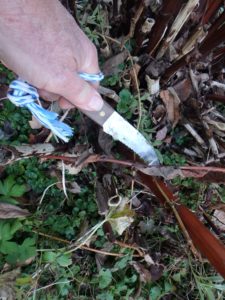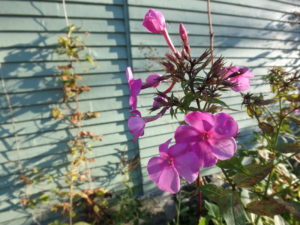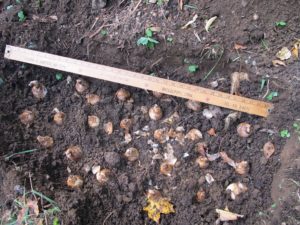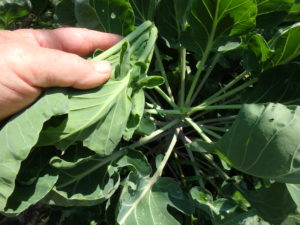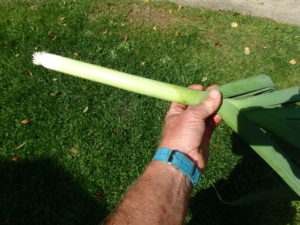Putting the Garden to Bed
Early autumn is a great time to work in the garden, and it’s not too early to start putting your garden to bed. I can work early in the morning without layers of wool, and my hands don’t need gloves to stay warm. Too often we gardeners wait until later, when frost is on the garden, to clean up. Start now, do a little each day, and the job will not be onerous.
Start by removing anything that is ugly. Your bleeding hearts (Dicentra spectablilis) has foliage that is yellow and has collapsed. Cut it out! Peonies may have dark blotches on the leaves – a potential sign of a fungal disease called botrytis – and should be removed.
Anything that looks like it is diseased should not go in the compost pile, but in the household trash or on a burn pile for winter. Be sure to cut right to the ground when removing foliage. Yes, you have to bend down a little lower, but the close to the ground, the better. That way you will be more likely to remove any diseased portions, and it will look better in the spring.
I know many gardeners like hand pruners to remove foliage, but I find that a bit tedious. I like a serrated knife. I hold a handful of tops, and with one swipe of my knife I cut through it all. The same group of stems might take a dozen snips. I’m all for speed and efficiency when working in the garden.
Other techniques? Hedge shears will make quick work of a big clump of iris leaves. But make sure they are sharp. Modern electric hedge clippers work, too, but I have been known to cut off the cord. Be sure to plug into one of those special outlets with reset buttons (GFCI) if you using electric hedge clippers – they’ll save you from getting electrocuted!
I have one 50 foot bed that is 8 to 10 feet wide. I call it my Darwin bed, as plants compete for space. No weeding. It’s full of tall plants like Joe Pye weed, turtlehead, phlox and more (including goldenrod for the pollinators). In late October, but before snow, I will run over the entire bed with a riding lawn mower, blade all the way up, engine racing at full throttle. It works!
You may wish to leave some flowers for the birds. Nice seed pods on purple cone flowers and black-eyed Susans will please the finches in winter, and look great above a thin layer of snow. Decorative grasses will sway in the winter wind, and look good for at least a month or two. You can always clean them up in the spring, or during a winter thaw if so inclined (and wearing wool).
As you cut back your perennials you will notice some volunteer plants. Phlox is forever planting itself around my garden, as is great blue lobelia and (dis-) obedient plant. It is natural to say, “Oh, how nice, the phlox is spreading.” But do I really want more phlox? NO, if I did want more, I would have planted more. I’d really like a new color, not more of the same. So I’ll dig it up and put it at the end of the driveway in a throwaway plastic pot. “FREE” will stop traffic.
As you cut back, weed! That will require different body motions – and fewer aches and pains. You probably already know some weeds by name, and by root. Some are perennials or biennials with deep tap roots. Others have lateral roots with nodes that send up more weeds. Annual weeds pull up with little effort and have small roots – but thousands of seeds. Try not to shake out seeds from weeds that have bloomed and set seeds. They will be back to annoy you for years to come.
I bring 2 tools with me for weeding: a garden fork and a CobraHead weeder. The fork is great for deep-rooted weeds. I plunge it in or step on it to force it into hard soil, then tip it back, loosening the soil. The weed, along with the deep root, will come right out, particularly if the soil is moist.
The CobraHead weeder has a single curved tine with a widened tip. It has become an essential tool for me; it’s like a curved finger. I use it to get under a weed. It allows me to lift and loosen soil beneath a weed while I tug on the top. If there are lateral roots, I tease them out, tugging and loosening until I have the entire darn thing.
Nothing beats crawling on your hands and knees for finding weeds. You are at their level. But if it’s hard for you to get back up, maybe you’d like to sit on something, particularly if the soil is cold and wet. I sometimes use a 5-gallon pail, but have seen some nice kneeling seats designed for gardeners, and have heard nice things about them. But to each her own.
Mulching? That can be the last step of fall clean up. Finely ground bark mulch or chipped leaves can be good for keeping down weeds, but don’t use too much. And try to keep it back from the crown, or center growing area of the plant. You can ruin peony’s ability to bloom by covering it with 3 inches of bark mulch. And avoid buying bagged mulch that is “color enhanced”. It has chemicals in it.
Me? I like flower gardens that have big clumps of perennials and lots of groundcover plants to cover bare spaces. That’s what Mother Nature does. I don’t like big swaths of bark mulch, though I use some in newer beds.
So go get to work on a nice day. It will save you time in the Spring.
Read Henry’s blog posts at https://dailyuv.com/
When – and How – To Plant Bulbs for Spring Blossoms
When the soil drops to 60 degrees Fahrenheit at proper planting depth, you can plant bulbs. You’ll need a soil thermometer, but that’s a handy device anyway – they’re useful in the spring to see if the soil is warm enough to plant tomatoes or eggplants without making them recoil in shock like a sixth grader wading into a chilly pond.
Soil thermometers are similar to the probes sold for testing turkey temperatures in the oven. A steel probe with a dial on top. You just poke it into the soil and wait a moment. Sometimes I put a pieces of tape at different locations: 3 inches for crocus, 6 inches for daffodils, 8 inches for tulips. Then I can easily see the temperature without digging. They are available at garden centers, or on-line.
Why sixty degrees? In soil warmer than that, your bulbs may sprout, thinking it’s spring. That’s not lethal, but not desirable. You do want the soil warm enough so that the bulbs will establish roots now, getting them ready for action in spring and holding them in place against frost heaves.
I tested the soil in a few places recently to see if it’s ready to plant. In full sun in my vegetable garden, the soil was slightly above 60 degrees, but in a shady flower bed the soil was in the high fifties. And down 8 inches it was 4 or 5 degrees cooler. I’ll plant crocus later, as the soil at crocus depth (3 inches) is warmer than deep down.
I bought my house 47 years ago, and I’ve been planting bulbs most years ever since. Most places suitable for bulbs, have bulbs. So this year I shall plant some in the lawn. Not daffodils, as the foliage can’t be cut back until July, and that would keep the lawn looking unkempt. But I could plant small bulbs like crocus, snowdrops or scilla. Their foliage dies back early enough that I’ll be able to mow the lawn when needed without compromising the bulbs. I’ll plant them by poking holes in the lawn with my CobraHead weeder (www.CobraHead.com).
Some years ago I was visiting a garden in Wales. The gardener had a bucket of tennis balls, and was tossing them onto the lawn. “What in the world are you doing,” I asked. He explained that he wanted to plant bulbs in a random pattern. Wherever a ball landed, he planted a bulb. Maybe I’ll try that.
I like to consider tulips as annuals. They do come back in year two at about 50 percent of year one, and year 3 is usually about 50 percent of that. So in general I buy 100 tulips, plant them all in the vegetable garden, and enjoy a big burst of color. I cut most and use in the house, or as gifts. I plant right over them after blooming, not worrying at all if they survive. A few will pop up in the lettuce the following year.
Daffodils are not attractive to rodents or deer as bulbs or as flowers. In fact, they are vaguely poisonous. But tulips are tasty to critters. Last year I planted a few cloves of garlic in with my tulips to repel rodents. I don’t generally have trouble with deer – I have a ferocious corgi who scares them off. They think she is a wolf, I suppose.
If you have deer problems, you probably will want to plant tulips in big swaths and then surround them with a temporary fence before they bloom. Even a 4-foot chicken wire fence should deter them, I think. There are repellents, of course, but I’ve never used any with tulips.
I have 3 books in my personal library about bulbs. All say to plant tulips and daffies 6 inches apart. I don’t. It uses too much space. I plant them three inches apart, and they do fine.
There are two keys to success when planting most spring-blooming bulbs: First, plant in full sun. Yes, in principle, you can plant daffodils in the woods if there are no evergreens and they will get enough energy from the sun before the maples leaf out. But they will do better in a sunny border. Root competition from trees diminishes their vigor.
Second, plant bulbs in soil with good drainage. Soggy soil is a death knell to most bulbs. If you have a heavy clay soil that holds water, plant your bulbs on a slope. Toss away half the soil you dig out and mix a light, fluffy compost with the other half. Dig deeper than needed, and fill with that same fluffy mix.
I don’t regret a penny I’ve spent on bulbs. Yes, some can be expensive. Yes, some don’t perform well. But by the end of a long New England winter I am so ready for blossoms I am willing to do almost anything (short of a deal with the devil) to get flowers blooming outdoors.
So go buy bulbs now. Later, when it’s time to plant, the best ones will be sold out. Start at your local garden center and look on-line for a few fancy things. Do this every year, and you’ll be delighted!
Is it okay to prune shrubs now? Learn which ones can be pruned by reading Henry’s blog post at https://dailyuv.com/news/
Six Fall Chores to Do This Weekend in the Vegetable Garden
Labor Day has come and gone. Big yellow buses are slowing traffic twice a day. But it’s not time to give up on gardening and move on to watching football and waiting in a Lazy-Boy for the maple leaves to turn red. Your gardens still need you. Let’s look at the vegetable garden.
My Brussels sprout are the size of peas, very small for the time of year. But I know how to fix that. I just cut off the top cluster of leaves. That will prevent the plant from using its energy to get taller. Instead it will pump up the “sprouts” we love to eat into big, healthy veggies.
Pumpkins and winter squash need the knife, too. They will continue to elongate their stems, growing out of the garden and across the lawn. But a blossom starting now will have little chance of maturing into a potential Jack-O-Lantern. So nip off that vine and let the energy from the sun and the minerals from the roots go to the fruits that have some chance of success.
Most tomatoes are what we call “indeterminate”. That means they will continue to grow taller until they are killed by frost. Most Roma-type tomatoes (plum) are determinate, as are a few others used mainly for canning or growing in pots. They reach full size and then concentrate on producing one load of fruit that can be picked and canned. But Big Boys and most heirlooms will continue getting taller, which can be a problem.
I’ve seen tomato plants 30 feet tall in commercial greenhouses. They grow up ropes that can be lowered down for picking. But you probably are not equipped to deal with tomato plants that are even 8 feet tall. So nip off the tips of tall branches.
If you haven’t been paying attention to your tomatoes for a few weeks, you might well have some fruit laden branches laying on the ground. These are much more susceptible to rot than fruit that is tied to a stake or cage. Lift the branches and tie them to the outside of the tomato cage. I recently was give some old panty hose that I cut into strips and used to tie up mine. It’s soft and stretchy, and does a great job. String is not perfect for the job as it can cut into the stems. Old bed sheets can be cut into strips for the job instead.
Potatoes are reaching full size for many gardeners. I plant mine later than most (mid-June) and they still have nice green leaves that are turning sunshine, carbon dioxide and water into carbohydrates that will keep me plump all winter. But if yours have brown leaves, you can dig them now. Or you can steal a few by reaching under a plant or two and grabbing a spud for dinner, but leaving the plant itself undisturbed.
As with any plant that is susceptible to fungal diseases, I do not toss potato plants onto the compost pile. Squash, tomatoes and potatoes all fall into this category. I carefully dig all the plants (including leaves and roots) and put them on a brush pile I will burn this winter after snow falls. If you don’t have a burn pile, you can put them in household trash or create a separate pile in a far corner of your property. I do that to minimize fungal diseases next year.
Leeks are ready to harvest, but can stay in the ground a few more weeks. I use leeks not only for leek and potato soup, but also as a substitute for onions. And you don’t have to just use the white part of leeks. Commercial growers hill soil over the leeks as they grow, keeping a longer portion white than I do. But most of the green part of the stem is good to use, too. I pick every other one now, thinning them out, and leaving some to get even bigger.
My peppers are pathetic this year. I only planted a few, some Hungarian wax and a few sweet peppers. I got a few of the hot wax peppers early on, but the cool, rainy summer has not encouraged most plants to blossom and produce fruit.
By now my peppers must be scared that winter is coming and they have not produced enough seeds to keep their line of DNA alive. We had one night where the temperature went down to 33 degrees! That should have been a wake-up call. So I am hoping that they will bloom and produce some fruit during the hot Indian Summer days that are sure to come.
I am trying an experiment with my peppers this year. On Labor Day I dug up 2 Hungarian hot wax peppers and transplanted them into 8-inch pots. I used potting soil, not garden soil in the pots as it will stay fluffier than garden soil, which tends to compact in a pot. I am keeping them in the garden, but will carry them inside any time the temperature is predicted to go much below 50 degrees. Then I’ll carry them outside again in the morning, sort of like walking the dog. They are wind-pollinated, so being indoors will not be a problem. I’ll let you know if I get some peppers this way.
As a rabid, mad-dog gardener I never stop thinking about my garden. There is always something to try – which keeps me young.
Do you suffer from hay fever? Read about the true culprit at Henry’s blog https://dailyuv.com/news/



